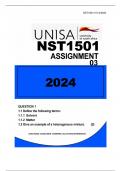NST1501/101/0/2024
, This assignment contains 3 questions, of which all are COMPULSORY.
QUESTION 1
1.1 Define the following terms:
1.1.1 Solvent
Solvent: A solvent is a substance that is able to dissolve other substances,
usually solids, liquids, or gases, to form a solution. Common solvents include
water, ethanol, and acetone. Solvents are commonly used in laboratory
settings, industrial processes, and everyday household activities such as
cleaning.
Reference:https://www.merriam-webster.com/dictionary/solvent
1.1.2 Matter
Matter is anything that has mass and takes up space. It is composed of
particles such as atoms and molecules. Matter can exist in various states,
including solid, liquid, and gas.
Reference: https://www.britannica.com/science/matter-physical-science (4)
1.2 Give an example of a heterogenous mixture. (2)
An example of a heterogeneous mixture is a bag of mixed nuts, which contains a
combination of different types of nuts such as almonds, peanuts, and cashews.
Reference: https://www.chem.purdue.edu/gchelp/liquids/homohet.html
1.3 Identify 2 different ways of separating homogenous mixtures (4)
1. Filtration: This method involves passing a mixture through a filter, which allows the
liquid components to pass through while trapping the solid components. An example
of this is separating sand from water.
2. Distillation: This method involves heating a mixture to vaporize the components
with different boiling points, then condensing and collecting the vapors. An example
of this is separating alcohol from water in the process of making spirits.
Reference:
Holler, F. J., Crouch, S. R., & Skoog, D. A. (2013). Principles of instrumental
analysis. Cengage Learning.
2




